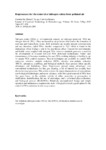Mostrar o rexistro simple do ítem
Bioprocesses for the removal of nitrogen oxides from polluted air
| dc.contributor.author | Jin, Yaomin | |
| dc.contributor.author | Veiga, María Carmen | |
| dc.contributor.author | Kennes, Christian | |
| dc.date.accessioned | 2014-10-28T12:32:10Z | |
| dc.date.available | 2014-10-28T12:32:10Z | |
| dc.date.issued | 2005 | |
| dc.identifier.citation | Jin Y, Veiga MC, Kennes C. Bioprocesses for the removal of nitrogen oxides from polluted air. Journal of Chemical Technology and Biotechnology. 2005;80(5):483-94 | es_ES |
| dc.identifier.other | DOI: 10.1002/jctb.1260 | |
| dc.identifier.uri | http://hdl.handle.net/2183/13738 | |
| dc.description.abstract | Nitrogen oxides (NOx) of environmental concern are nitrogen monoxide (NO) and nitrogen dioxide (NO2). They are hazardous air pollutants that lead to the formation of acid rain and tropospheric ozone. Both pollutants are usually present simultaneously and are, therefore, called NOx. Another compound is N2O which is found in the stratosphere where it plays a role in the greenhouse effect. Concern for environmental and health issues coupled with stringent NOx emission standards generates a need for the development of efficient low-cost NOx abatement technologies. Under such circumstances, it becomes mandatory for each NOx-emitting industry or facility to opt for proper NOx control measures. Several techniques are available to control NOx emissions: selective catalytic reduction (SCR), selective non-catalytic reduction (SNCR), adsorption, scrubbing, and biological methods. Each process offers specific advantages and limitations. Since bioprocesses present many advantages over conventional technologies for flue gas cleaning, a lot of interest has recently been shown for these processes. This article reviews the major characteristics of conventional non-biological technologies and recent advances in the biological removal of NOx from flue gases based on the catalytic activity of either eucaryotes or procaryotes, ie nitrification, denitrification, the use of microalgae, and a combined physicochemical and biological process (BioDeNOx). Relatively uncomplicated design and simple operation and maintenance requirements make biological removal a good option for the control of NOx emissions in stationary sources. | es_ES |
| dc.language.iso | eng | es_ES |
| dc.publisher | Wiley-Blackwell | es_ES |
| dc.relation.uri | http://dx.doi.org/10.1002/jctb.1260 | es_ES |
| dc.rights | The definitive version is available at http://onlinelibrary.wiley.com/ | es_ES |
| dc.subject | Air pollution | es_ES |
| dc.subject | Nitrogen oxides (NOx) | es_ES |
| dc.subject | BioDeNOx | es_ES |
| dc.subject | Nitrification | es_ES |
| dc.subject | Denitrification | es_ES |
| dc.subject | Microalgae | es_ES |
| dc.title | Bioprocesses for the removal of nitrogen oxides from polluted air | es_ES |
| dc.type | info:eu-repo/semantics/article | es_ES |
| dc.rights.access | info:eu-repo/semantics/openAccess | es_ES |
Ficheiros no ítem
Este ítem aparece na(s) seguinte(s) colección(s)
-
GI-BIOENGIN- Artigos [106]






